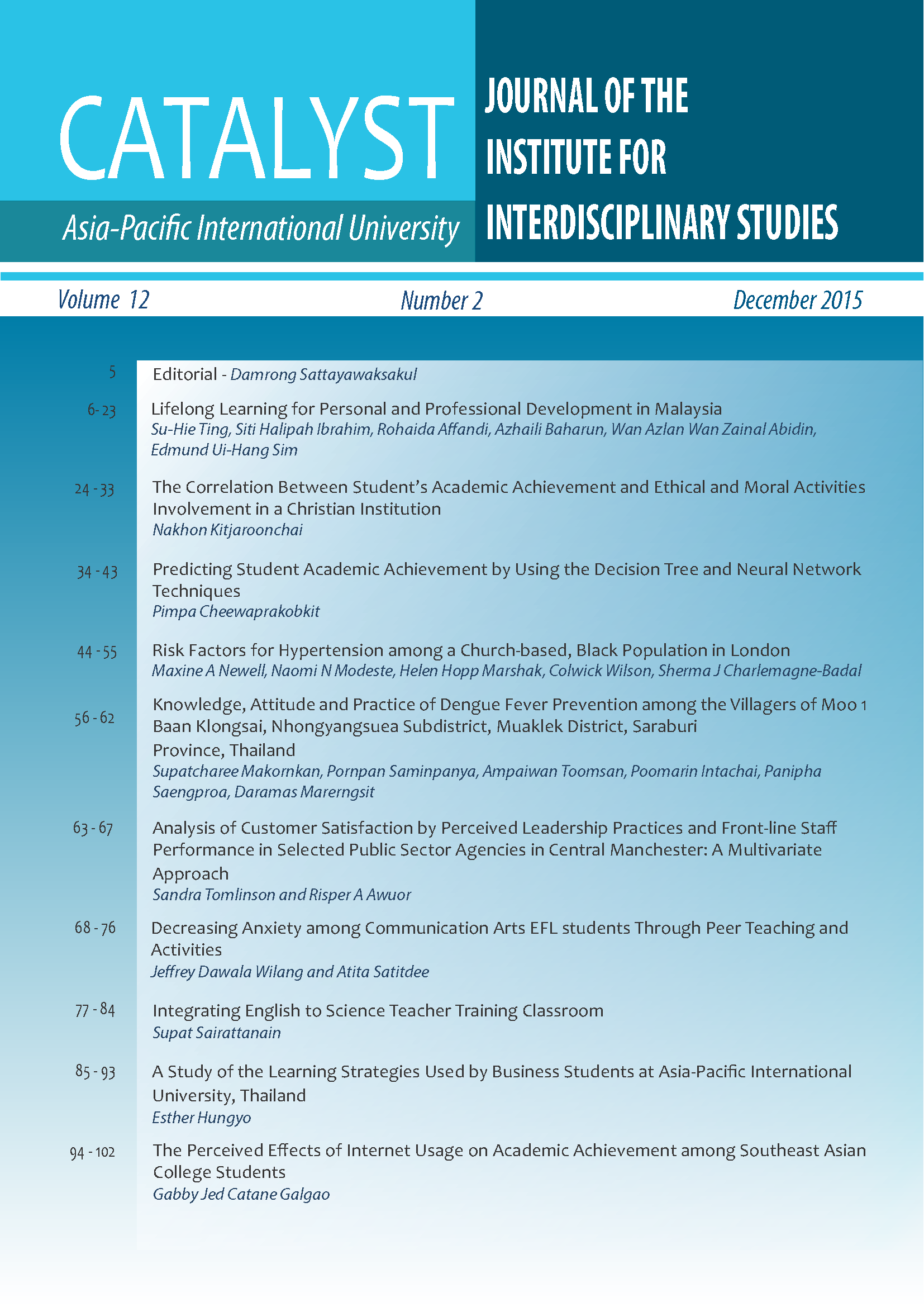Decreasing Anxiety among Communication Arts EFL Students Through Peer Teaching and Activities
Main Article Content
Abstract
This paper reports the results of a longitudinal study aimed to create classroom activities that can lead to the reduction of speaking, listening, reading, and writing anxieties in English language learning of Thai undergraduates major in Communication Arts in a university in Thailand. Four widely-used anxiety scales were utilized such as Foreign Language Listening Anxiety Scale (FLLAS) by Kim (2000) for listening anxiety, Personal Report of Communication Apprehension (PRCA) by McCroskey (1982) for speaking anxiety, Foreign Language Reading Anxiety Scale (FLRAS) by Saito et al. (2009) for reading anxiety, and Second Language Writing Anxiety Inventory (SLWAI) by Cheng (2004) for writing anxiety. Results of the study reveal that the participants are more anxious with their receptive skills (listening and reading, M=3.49 and M=3.39 respectively) as compared with their productive skills (speaking and writing, M=3.35 and M=3.38 respectively). Moreover, the highest anxiety provoking situations in each language skill include inability to differentiate words in listening (M=3.73), inability to understand what is being read (M=3.62), using English in writing a composition (M=3.67), and forgetting facts while speaking (M=3.57). The above findings are crucial on how language teaching is designed this ongoing semester.
Article Details

This work is licensed under a Creative Commons Attribution-NonCommercial-NoDerivatives 4.0 International License.
Copyright: Asia-Pacific International University reserve exclusive rights to publish, reproduce and distribute the manuscript and all contents therein.
References
Burden, P. (2004). The teacher as a facilitator: reducing anxiety in the EFL university classroom. JALT Hokkaido Journal, 8, 3-18.
Casado, M., & Dereshiwsky, M. (2001). Foreign language anxiety of university students. College Student Journal, 35(4), 539-551.
Cheng, Y.S. (2004). A measure of second language writing anxiety: Scale development and preliminary validation. Journal of Second Language Writing, 13(4), 313-335. doi:10.1016/j.jslw.2004.07.001.
Cheng, X. (2004). English listening comprehension and anxiety. Computer-Assisted Foreign Language Education, 96, 65-72.
Elkhafaifi, H. (2005). Listening comprehension and anxiety in the Arabic language classroom. The Modern Journal, 89(2), 206-220.
Golchi, M. M. (2012). Listening Anxiety and Its Relationship with Listening Strategy Use and Listening Comprehension among Iranian IELTS Learners. International Journal of English Linguistics, 2(4), 115-128.
Gregersin, T., & Horwitz, E. (2002). Language learning and perfectionism: Anxious and non-anxious language learners reactions to their own oral performance. The Modern Language Journal, 86, (4), 562-570.
Horwitz, E. K., Horwitz M. B., & Cope, J. A. (1986). Foreign language classroom anxiety. The Modern Language Journal, 70, 125-132.
Joo, K. Y., & Damron, J. (2015) Foreign language reading anxiety: Korean as a foreign language in the United States. Retrieved from http://www.ncolctl.org/.
Kim, J. (2000). Foreign language listening anxiety: A study of Korean students learning English. Unpublished doctoral dissertation, University of Texas-Austin.
Kurt, G., & Atay, D. (2007). The effects of peer feedback on wiritng anxiety of prospective Turkish teachers of EFL. Online Submission, 3(1), 12-23.
Loreto, S., & McDonough, K. (2013). The relationship between instructor feedback and ESL student anxiety. TESL Canada, 31(1), 20-41.
MacIntyre, P. D. (1995b). On seeing the forest and the trees. A rejoinder to Sparks and Ganschow. The Modern Language Journal, 79, 245-275.
Mak, B. (2011). An exploration of speaking-in-class anxiety with Chinese EFL learners. System, 39, 202-214.
McCroskey, J.C. (1982). An introduction to rhetorical communication. Englewood Cliffs, NJ: Prentice-Hall.
Pae, T. (2013). Skill-based L2 anxieties revisited: Their intra-relations and the interrelations with general foreign language anxiety.
Saito, Y., Garza, T. J., & Horwitz, E. K. (2009) Foreign language reading anxiety. The Modern Language Journal, 83(2), 202-218.
Saito, Y., & Samimy, K. (1996). Foreign language anxiety and language performance: A study of learner anxiety in beginning, intermediate and advanced level college students of Japanese. Foreign Language Annals, 29(2), 239-249.
Shi, Y. Z., & Liu, Z. Q. (2006). Foreign language reading anxiety and its relationship to English achievement and gender. Journal of Pla University of Foreign Languages, 2, 013.
Yastibas, G., & Yastibas, A. (2015). The effect of peer feedback on writing anxiety in Turkish EFL (English as a foreign language) students. Procedia – Social and Behavioral Sciences, 199, 530-538.
Yim, S. (2014). An anxiety model for EFL young learners: A path analysis. System, 42, 344-354.
Zhang, L. (2000). Uncovering Chinese ESL students’ reading anxiety in a study-abroad context. Asia Pacific Journal of Language in Education, 3, 2 31-56.
Zhang, X. (2013). Foreign language listening anxiety and listening performance: Conceptualizations and causal relationships. System, 41, 164-177.


